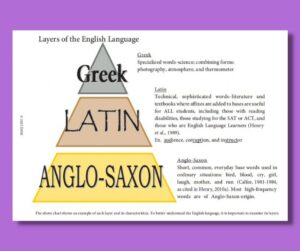Anglo-Saxon
The Anglo-Saxon layer of our English language is the oldest. This layer comes to us through the settlement of the Angles, Saxons, and Jutes in England. Our Anglo-Saxon words are our short, common base words used in everyday language. Examples of words with an Anglo-Saxon origin include bird, girl, mother, laugh, and wash. These words are used in ordinary situations and are found throughout texts. Most high-frequency words (e.g., Dolch, Fry) come to us from this layer.

Anglo-Saxon bases are free morphemes, meaning they can stand alone. They can also take affixes (e.g., misspell, hopeless). Sometimes two Anglo-Saxon bases combine to form compound words (e.g., blackboard, football, mailbox).
When beginning instruction in morphology, compound words provide a beneficial transition, or bridge, to understanding how other morphemic elements (e.g., prefixes, suffixes) impact the meaning of a base word. Because compound words are made of familiar base words, using them to introduce the idea of morphemes scaffolds instruction for students. Students can complete an activity in which they make a foldable to illustrate each base word inside a compound word and the meaning of the resulting compound word formed when the bases are combined: (Insert pic of mailbox foldable from Comprehensive slides.)
Students can then build upon this knowledge of morphemes, or units of meaning within a word, as teachers begin to introduce prefixes and suffixes with known Anglo-Saxon bases.
